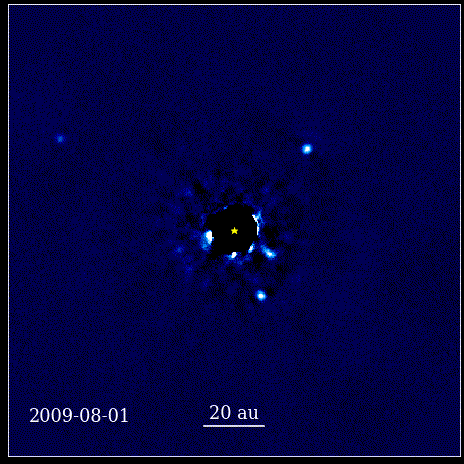At first sight, the video below might be confused with an amateur’s effort at filming Jupiter and the movements of its largest moons. However, the timer and scale bar reveal, the darkness at the center obscures a star 133 light years away, and each of the moving dots represents a gas giant larger than Jupiter itself, filmed over a period of 12 years.
The vast majority of the planets we know of outside the Solar System (exoplanets) have never been seen directly. We know of them through the movements their gravity induces in the star they orbit, and sometimes from the dimming they produce in the star as they pass across its face.
Even those planets large and close enough that we could see them with existing telescopes are usually drowned out by the light of their star. The JWST has changed this situation a little, and forthcoming telescopes will allow us to see even more exoplanets directly. Nevertheless, there are too many calls on our best instruments’ time to view many planets this way.

The four exoplanets orbit their star, which has been blocked out as its glare is so intense it blocks out the planets. Image credit: Jason Wang/Northwestern University
The HR8799 system is an exception, along with the more famous Beta Pictoris. Not only is it relatively close by galactic standards, but the system is so young the planets haven’t lost most of their heat of formation. Instead of shining purely with reflected light, they still emit their own, albeit mostly in the infrared. The fact they are enormous, and some orbit at distances greater than Neptune, also helps.
The star HR8799 is only 30 million years old, and its planets even younger. At 1.5 solar masses, it won’t live as long as the Sun, but it’s still only gone through about 1 percent of its lifespan. These facts drew astronomers’ attention and in 2008, HR8799 became the first system whose planets we directly imaged. Dr Jason Wang of Northwestern University has been watching it ever since using the Keck Observatory on Mauna Kea, Hawaii, at least once a year.
Now, Wang has stitched together the images from those observations into a timelapse. We’re fortunate we have a bird’s eye view of the HR8799 system, so we get a more complete version of the planets’ orbits than we do of Jupiter’s moons, which we see almost side on.
“It’s usually difficult to see planets in orbit,” Wang said in a statement. “For example, it isn’t apparent that Jupiter or Mars orbit our sun because we live in the same system and don’t have a top-down view. Astronomical events either happen too quickly or too slowly to capture in a movie. But this video shows planets moving on a human time scale. I hope it enables people to enjoy something wondrous.”
“There’s nothing to be gained scientifically from watching the orbiting systems in a time lapse video,” Wang added. “But it helps others appreciate what we’re studying,”
Even planets as large and young as those of HR8799 are not automatically visible. Wang had to use a coronagraph to hide the light of the star and adaptive optics to overcome the blurring caused by Earth’s atmosphere to allow us to spot the planets. Even then, some video processing was required to smooth the apparent movements.
Source Link: Incredible Time-Lapse Shows Planets’ 12-Year Dance Around Their Star